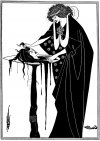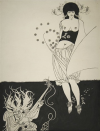Jackie1111
Tribune
I froze and my heart skipped a beat as I heard the call: "Jackie, your turn to dance!"


Even more than you indicate. The play was written in French in 1891 and published in an English edition with illustrations by Aubrey Beardsley* in 1894. Wilde never saw the play produced. The only performances given in his lifetime were in 1896, in the original French by which time he was serving a prison sentence for illegal homosexual activity. In the UK, plays depicting Biblical characters were banned. The American movie was made in 1922 and shown in 1923. The first public performance in the UK, was on October 5th, 1931, a full forty years after it was written!Richard Strauss's opera had been performed at the Met once, in 1907, but there was enough puritanical pressure from wealthy patrons to prevent it sullying the pure minds of NY audiences again until 1934. So the film was a daring experiment

Here's Aubrey Beardsley's 'Harem Girl' to get us back on the strait and narrowEven more than you indicate. The play was written in French in 1891 and published in an English edition with illustrations by Aubrey Beardsley* in 1894. Wilde never saw the play produced. The only performances given in his lifetime were in 1896, in the original French by which time he was serving a prison sentence for illegal homosexual activity. In the UK, plays depicting Biblical characters were banned. The American movie was made in 1922 and shown in 1923. The first public performance in the UK, was on October 5th, 1931, a full forty years after it was written!
*Beardsley's prints are amazing:
View attachment 1030909
OK. I'm through hijacking the thread. Back to the amazing @Jackie1111 mesmerizing dances.
 :
:

Interesting head gearSome wonderful contributions and finds the past few days. I hope you appreciated this vintage pic of me, dancing my heart out..


A picture of the same slave from the front.

A willing slave that knows their placeA picture of the same slave from the front.
View attachment 1031974
Her stance keeps her impressive and permanently exposed breasts proudly on display, and does so confidently as she knows they indicate her true value.
I think this is before the previous picture. Although a prized slave can be allowed a sheet of cloth, which she can keep draped over her waist like a skirt, here, she is required to offer and present herself completally naked. The status granted to her by her token piece of clothing is only momentary, as she is reduced to her basic role as a slave, which she willingly fufills.









All this 80's hairstyle and make-up! Did I really like this back then???A while back, I saved some pictures from a site or blog, detailing some movie. But unforutunatly, I can't find it or remember what the film was called, but from the file names, it features both Becky LeBeau and Blondi Bee.
View attachment 1033394
I love their casual demeanor, showing that their appearance as slaves, has become completally natural to them, and are even proud that their naked body and breasts are always on display, and decorated with ornaments.
I especially like the taller one on the right, and appreciate that she is only given that golden thong to wear, so that body is always kept on display.
Here are some other picture:
View attachment 1033391View attachment 1033390View attachment 1033389View attachment 1033392View attachment 1033393View attachment 1033395View attachment 1033396







So, the idea of slavegirls came from a specific cultural or literay movement. Slavegirls did exist, but there wasn't any signifigant cultural recognition before then. And the western/orientalist interpertation drew from that.The connection between erotology and slavery, or the erotic connotation given to texts related to slave girls, was well attested in the Abbasid period when, beside medical books on coitus (bāh), a new kind of treatise appeared, which Ibn al-Nadīm considered written in a new sexually arousing style. Revealing titles like Kitāb al-ḥurrah wa-al-amah (The Book on the freewoman and the slave girl) and Kitāb al-jawārī al-ḥabāʾib (The Book of the beloved slave girls) belong to this genre, which a century later was already popular. This new genre of texts, and in general ʿilm al-bāh, relied considerably on the institutions of slavery and concubinage: it is thus obvious that “authors of the bāh-books took it for granted that their male readers had concubines at their disposal or could at least purchase one if they wanted.” The intimate association between eroticism and slavery is due to the fact that licit sexual activity in Muslim society can be in the frame of marriage (nikāḥ) or in the frame of the ownership relation between a man and his slave girls. Marriage and slavery were linked by analogy since both implied a kind of ownership (milk): in marriage (nikāḥ), the consequence of the payment of a certain sum was “the right to exclusive sexual access” while the purchase of slaves gave the right to “ownership of the physical person.” This analogy is also emphasized by Bouhdiba, who paradoxically claims that concubines were the double of wives (more precisely “anti-wives”) in that pleasure with them was devoid of any obligation.
The Representation of Slave Girls in a Physiognomic Text of the Fourteenth Century, by Antonella Ghersetti
So, the idea of slavegirls came from a specific cultural or literay movement. Slavegirls did exist, but there wasn't any signifigant cultural recognition before then. And the western/orientalist interpertation drew from that.
I think rather that something that had probably been a taken-for-granted part of middle Eastern society since the earliest urban civilisations was given a particular cultural colouring in that Abbasid context (thanks Serva for that very interesting note) There are of course several references in the Bible to slave-concubines as an accepted part of a patriarch's household, I think there's evidence for female slaves with sexual roles in ancient Egypt (both in the courts and the temples), and clearly erotic imagery of serving-girls, dancing girls and the like from farther afield - from Etruria to the Indus valley.So, the idea of slavegirls came from a specific cultural or literay movement. Slavegirls did exist, but there wasn't any signifigant cultural recognition before then. And the western/orientalist interpertation drew from that.
I meant as something that was widly recognize. Before the Abbasid period, they weren't talked or written about.What do you mean "the idea of slave girls"?
What do you mean "the idea of slave girls"?
I meant they were probably already taken for granted, but they gained an increased cultural significance after the release of the literature that Serva mentioned.I think rather that something that had probably been a taken-for-granted part of middle Eastern society since the earliest urban civilisations was given a particular cultural colouring in that Abbasid context (thanks Serva for that very interesting note) There are of course several references in the Bible to slave-concubines as an accepted part of a patriarch's household, I think there's evidence for female slaves with sexual roles in ancient Egypt (both in the courts and the temples), and clearly erotic imagery of serving-girls, dancing girls and the like from farther afield - from Etruria to the Indus valley.
I think rather that something that had probably been a taken-for-granted part of middle Eastern society since the earliest urban civilisations was given a particular cultural colouring in that Abbasid context (thanks Serva for that very interesting note) There are of course several references in the Bible to slave-concubines as an accepted part of a patriarch's household, I think there's evidence for female slaves with sexual roles in ancient Egypt (both in the courts and the temples), and clearly erotic imagery of serving-girls, dancing girls and the like from farther afield - from Etruria to the Indus valley.
I meant as something that was widly recognize. Before the Abbasid period, they weren't talked or written about.
According to early Arabic historical sources, the Shi‘i rebel Zayd ibn Ali rose up against the Umayyad state in 740 CE and claimed the caliphate for himself. The Umayyad caliph Hisham (r. 724–743) learned of Zayd’s actions and scoffed, “You claim the imamate [i.e., the caliphate] when your mother is a slave? The imamate is not suitable for the children of slave women.”
Zayd responded by invoking the figure of Hagar (Arabic, Hajar), concubine of Abraham (Arabic, Ibrahim) and mother of the Prophet Ishmael (Arabic, Ismail). If God deemed Ismail worthy of prophethood while his mother was a slave, why should Zayd not be worthy of the caliphate? Zayd’s revolt proved abortive, but the question of whether a slave-born man could legitimately hold the caliphate remained open. After the Abbasid revolution brought an end to the crumbling Umayyad state in 132/749, the second Abbasid caliph, Abu Jafar al-Mansur, also defended his right to rule as the son of a slave woman. In this case, the Shi‘i rebel Muhammad al-Nafs al-Zakiyya (“The Pure Soul”) renounced the fledgling Abbasid state in 145/762–763 and asserted his own authority as the noblest Arab, “the purest of both mother and father.” Al-Mansur responded by calling on the figure of Mariya the Copt, concubine of the prophet Muhammad and mother of his son Ibrahim, who died in infancy. If the Prophet himself had deemed a slave woman worthy of bearing his son—who has the best lineage of all—why should al-Mansur not be worthy of the caliphate? Thus, two prominent men living in the mid-eighth century invoked two paradigmatic slave mothers from the Islamic religious tradition to justify their own political pretensions.
Concubines and Courtesans (p. 225). Early Islamic Models of Slave Motherhood. Elizabeth Urban.
I think during the Abbasid caliphate, the market economy for slaves (along with other 'luxury' merchandise) expanded greatly. It was during this time that the 'Viking' trade routes down to the Black Sea and Caucasus developed, supplying an insatiable demand for pale-skinned Scythian and Caucasian girls.Concubinage in the Islamic world goes back to Muhammad who had at least two slave-concubines, Maria the Copt (who mothered Ibrahim) and Rayhana, a Jew of Medina.
They were long before the Abbasid period. The Abbasid period was more "decadent" so to speak than the Umayyad and Rashidun caliphates, but in these two previous stages there was still widespread sexual slavery. Much of Sunni jurisprudence on the subject of sexual slavery draws from the precedents set by Muhammad and his companions (including the first four caliphs but not limited to them). Sexual slavery in the Abbasid period reached new heights of consumption and scale, and yes, increased sexualization, but to be clear, sexually slavery was normalized before then. The Quran says that all women are forbidden "to you, except your wives, and what your right hand possesses". Possessed by the right hand is the euphemism for slavery, and a phrase hereafter utilized in Islamic literature.
